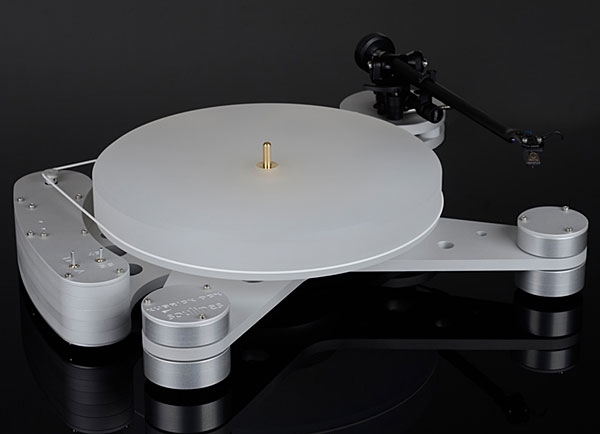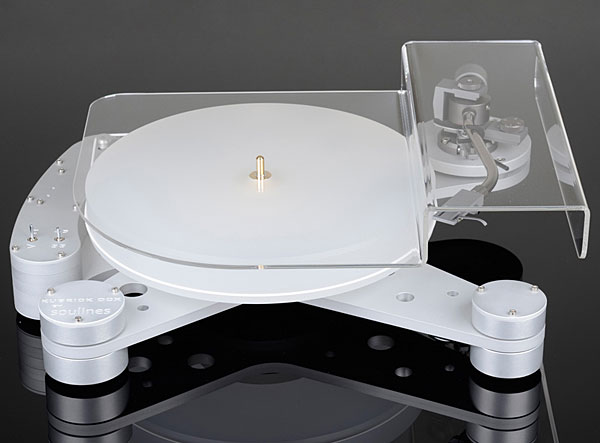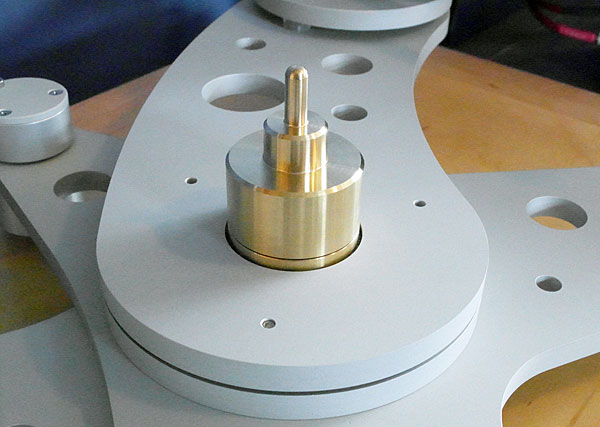| Columns Retired Columns & Blogs |
I'm struck by how similar this design looks to an Avid TT. it's a bit prettier, but otherwise, virtually identical.

Now I see dozens of high-end audio manufacturers popping up every year, with new turntable companies leading the charge. Virtually all of them offer at least a half-dozen different turntables, and sometimes the various models in a given company's line represent a variety of different design philosophies: You want high-mass, we got high-mass. You want low-mass, we got low-mass. Whatever you want, we got it. Those companies act as if they're in the toothpaste business: They offer a bazillion different choices, just so they can occupy more shelf space or catalog pages than their competitors—and their competitors will always be more than happy to up the game and demand even more space on those shelves and pages.
So I was cheered when, at the 2015 New York Audio Show, in suburban Rye Brook, New York, I first encountered the Serbian turntable manufacturer Soulines (footnote 1). All five of their models featured acrylic platters, belt-driven by DC motors of moderately low torque. (I define moderately low torque as just enough to start the platter spinning without assistance, but low enough that the platter or motor can be easily stopped by hand.) Each model was no larger than necessary to accommodate a 12" platter and a 9" tonearm. The plinths or chassis of all were on the low-mass side of average—though apparently not as low as, say, the plinth of a Rega Planar 3. There appeared to be a point of view at work here, and you know how I love those.
The icing on the cake was that all five Soulines models came with a cleverly designed, minimalist dustcover, and each turntable was fancifully named for a famous individual: two composers, one novelist, one film director, and one Greek god—respectively, Elgar, Satie, Dostoyevsky, Kubrick, and Hermes. These elements, and the fine sound produced at NYAS 2015 by Soulines-fronted systems—this was in the suite sponsored by retailer Adirondack Audio & Video, Soulines' US distributor—offset whatever doubts I might have had owing to the Soulines' lacks of those design elements I've come to favor: heavy platters, idler-wheel drive, and, above all, high-torque motors. I wondered: might one of these turntables nonetheless shine in my system? Is there life beyond my own hi-fi hobbyhorses? I decided to find out—and, a year and a half later, I borrowed a review sample of Soulines' top-of-the-line turntable, the Kubrick DCX ($4000 without tonearm).

Its name a nod to the space station in the Stanley Kubrick film 2001: A Space Odyssey, the Kubrick DCX lacks a plinth in the usual sense, and is supported instead by a skeletal aluminum chassis in which three elongated pods of unequal length extend from a central point that also serves as a base for the platter bearing. Given the pods' unusual shape, accurately measuring each from the chassis center out to the center of its supporting foot wasn't possible, but I estimated 150mm for the rearmost pod, 200mm for the left-front pod, and 250mm for the right-front pod; interestingly, the supporting feet at the ends of those pods, also machined from aluminum, are also differently sized, with diameters of 40mm for the rear foot, 70mm for the left-front foot, and 60mm for the right-front foot. (On their website, Soulines claims for the Kubrick's design an adherence to the Golden Ratio/Fibonacci sequence, but without going into detail; while noting my lack of mathematics training or any intuitive sense of spatial relationships, I just don't see it.) The height of each foot is adjustable, and all have rounded, soft-polymer tips.
The platter bearing is an inverted type: a stainless-steel axle is held stationary within a round brass plate that's rigidly affixed to the center of the chassis; a steel ball sits in a recess atop that axle, on which rides a very hefty and obviously well-machined brass outer hub with a diameter of 45mm and a bore just large enough to accept the whole of the bearing shaft, with freedom of rotation but zero apparent play. A small amount of 30-weight synthetic oil is used between the shaft and the hub. The 40mm-thick acrylic platter is machined with a bore that snugly fits atop the brass bearing hub, which is also fitted with a record spindle. The platter, whose edge is ungrooved, is driven by a polymer belt of round cross-section; supplied with the Kubrick are two belts, one black, one white, apparently made of two different materials. I thought the turntable sounded pleasantly louder and more forward with the white belt, but I may have imagined that.

Another aluminum pod of sorts is fastened to the underside of the main chassis with 32 stainless-steel bolts; this extends into a vaguely kidney-shaped substructure built up of multiple layers of machined aluminum, in which are mounted the Kubrick's DC motor and drive circuitry. On the kidneypod's upper surface are an on/off toggle switch, another toggle for selecting between 331/3 and 45rpm, and two tiny, recessed trim pots for fine-tuning those speeds with the aid of a similarly tiny screwdriver (not included).
A separate aluminum tonearm-support structure, also kidney shaped, attaches to the main chassis from above but is compliantly mounted, said compliance provided by cork washers and grommets of various diameter. To its outer end is bolted a round tonearm board, machined with an opening for the arm of choice. Three boards are supplied with the Kubrick: one for Linn/Jelco-style mounts, one for SME-style mounts, and one for Rega tonearms—which is the one I used, with my own Rega RB300.
Expectations confounded
The first thing that impressed me about the Soulines Kubrick DCX was its very well-designed and well-made packing. The sturdy white carton with its multilayer, compartmentalized foam inserts reminded me of the packing for the Linn LP12, Roksan Xerxes, and other products from long-established companies—and while many good products have reached me, intact, in far less sophisticated boxes, I'm always impressed when a manufacturer invests greater-than-average amounts of money and effort in getting their designs to their dealers and customers.
Setup was a breeze: The main chassis, support feet, motor pod, and tonearm pod are preassembled, and the Rega armboard—which can be used with either old-style single-nut RB250s and RB300s or newer three-bolt Rega arms—was already in place. My chores were limited to fitting the platter atop the pre-assembled, pre-oiled bearing, fitting the drive belt, installing the tonearm on the armboard, and installing and aligning my Denon DL-103 cartridge. For that last chore, the Soulines Kubrick DCX comes with a laminated alignment template with calibrations for the three most popular geometries: Baerwald, Stevenson, and Löfgren. Normally, my preference is for the Baerwald variation devised by Keith Howard (footnote 2), but for the sake of ease I sometimes opt for traditional Baerwald with my Rega arm, whatever the turntable. When the Kubrick arrived, I removed the RB300 from my LP12, cartridge intact—and was happily surprised to see that the cartridge alignment was still correct after I'd installed the arm on the Soulines. I took this as confirmation that its armboard was correctly machined.
Footnote 2: See Keith Howard's Arc Angles: Optimizing Tonearm Geometry," in the March 2010 issue.

Art,
I am glad you were "kidding" in your first paragraph. Otherwise I would have invited you to try what it is really like to have lived in the Soviet Union in the 1950's, toothpaste or not. You are a good writer and I generally like your stuff, but this was an inane intro. Sorry.

I am glad [Art was] "kidding" in [his] first paragraph.
About living in the Soviet Union, yes. About overwhelming choice, no. See the essay I wrote in 1998 about this marketing trend at www.stereophile.com/asweseeit/270/index.html, where I quoted Joni Mitchell on "Barangrill" (For the Roses, 1972): "The crazy you get from too much choice."
John Atkinson
Editor, Stereophile

Except for being so ugly, it's just another belt drive turntable. Ho hum.

And this is one awesome looking turntable. Very well machined!
I sooooo want one!
And very communicative review, AD.

Trouble is no one wants to buy my HW-19.

otherwise you are most likely asking too much for the offering. If it's a mk2 or early mk3, the issue is with cosmetics most likely. There are too many more modern turntables out there and the look is pretty 80's retro.. as I've owned one for the past 30 years.
The other issue is the platter weighing down the plinth over decades of use, and it will warp the plinth (if not the steel plate underneath as well). This holds very true for the mk3 and mk4 with the delrin/lead platters. It's a lot of weight that slightly dishes the center of the plinth (where the bearing well is). I also bought a 2nd plinth 3 months ago for that reason and cosmetics as well.
What about refinishing the base? Zip Strip it properly, sand and re-stain with an unique stain. If you polyurethane it well, it will seem much more attractive compared to those already out there. At least it might make you happy as well at the new look. I've done several.

Don't think I am asking too much, you can check it out yourself, it is on usaudiomart under volvic. I always said that I may have a better chance of selling it if I sell it off in pieces. It began as a junior and I slowly found the parts for it to bring it up to MK iii level. I do like it's tweak ability and the idea of dialing in the sra by lowering or raising the platter was always pretty neat. Sonically it's not bad, but its materials and fit and finish are not up today's standards. Plinth is fine and metal acrylic sandwich plate is flat to my eye with no dimple. It's not bad at all and has been quite reliable, but you read reviews like one above and hear the new Technics table or the SME 10 and you suddenly want to get THE last great turntable.

Excuse the off-topic thread here.
If the plinth is still the wood-only Jr. one, that is an obvious non-starter. I think you are talking about the black oak base, and not the plinth/sub-assembly, as you are implying you have the steel/mdf subchassis. The speed issues stated, another. (Who else would have the SDS that doesn't already have a VPI turntable? No one, though .4 rpms is not 'much' to whine about, as it is fast and not slow.)
The pulley is def another issue. The pulley shouldn't wobble, as the issue is probably with the connection to the motor base itself. If the motor shaft connection in the well is bent, non-starter... no fixing that, unless you can find a SAMA, which is now in 'good luck' territory. Simply, the Mk3 motor assembly triangle box introduces a lot of vibration into the system, and personally I would keep what you have and find a SAMA on that site, if another HW19 is parted out for such.
Huge upgrade and I would also recommend dispensing with all sorbothane, and rather go with Herbie's platinum silicone products for all connecting parts... Tonearm base to armboard junction, spike points and bases, motor mounting screws to oak base, platter to plinth subassembly, armboard screws gaskets for under the armboard to mate with the subassembly, and many more. Massive improvements, as the sorbothane does a junk job of negating vibrations vs. even blutack. In fact, though the Herbies' products are super cheap (the armboard gaskets are a less than a buck a piece), I would even say that replacing the sorbo with blutack at the motor to base junction points is a huge improvement (as well as covering all triangle sides in Blutack. Blutack simply does a better job of negating vibrations than sorbo ever did (with anything that weighs less than 100 pounds (heavy speakers..yeah, turntable parts... no). That being said, Herbie's silicone products destroy all of them. Seriously. (I can now firmly press my ear to the oak plinth and hear no humming vibrations whatsoever.)
All being said, I think $600 would be more appropriate or even create a new ad to satisfy. Higher res pictures would help, as well as more angles and a re-write with less talking to the 'negatives'. Sorry man, just looking at what I've seen from past offerings over the years.

I probably wasn't clear, there is no more wobble as the pulley is new and the motor is new, but the older pulley definitely has an issue. Good point on blutac the sorbothane has worked well there is no more vibration when I place a sthethoscope but blutac is better. I try and show the negative with the positive - prefer honesty.

and understood on the wobble clarification.
I don't want to imply that you should be dishonest, but rather re-write (and re-post) the offering so that each area of the focus is more clearly laid out. I just think there is some miscommunication about what you have there. It kind of scared me off when I read it (if I was a respective buyer).
Also, please be emphatic or clear about the new Isolators (from the Classic) installed that replaces the suspension. They do work nicely, though I use a set of Herbie's 1/8" circles over the tops, and it is transformative.
And yeah, cover the whole motor assembly in blutack at the least. It does a great job of containing vibes from the base. I also use blutack around the base skirt (inside), as well in the feet wells underneath. It works and the cost is nil.


Personally, I would strip and re-stain the turntable base and you may fall in love with it all over again. This is certainly the 'hobby' part that is fun. It's labor intensive, but one can remove the motor assembly and power button connection pretty simply and work on it unencumbered.
Keep in mind that unless got the dosh for a new turntable over $2500, it would be smarter to hang on to it until you are within $500 of the new purchase (whatever the new turntable may be). Even if someone gave you $1000 for it, that's 1/4 of the Soullines retail price.

As does a slightly used SME 10 for less and even the newer lower priced Vertere has my curiosity peaked. The issue is how much better are they? I have taken apart the HW-19 many times to improve or change motor or add the isolators and it is robustly made and is even more quiet than it ever was. My Dad always tells me you have three great tables; HW-19, new LP12 and a Technics 1200 waiting for a new SME IV or M2 tonearm to be mounted, just enjoy your records and stop looking for incremental upgrades. But I see this Soulines or SME 10 which I can afford and drool. But at some point all of this upgrade craziness has to stop.

Not sure where you live, but go out and listen to a set-up with the unit in-line. Yes, there are way too many variables at play in a dealership, but listening at some point is required. Without that, it is all speculation.
Remember that all reviews are a signpost to audition for yourself. You are not Mikey, John, Herb or Art.
You may or may not like what YOU hear.

But, I will be selling it, one could tweak it to the max, won't change its character nor build quality. It is a great turntable, but I have auditioned the SME 10 and the new Technics and think they are leagues ahead. In the end this is why we subscribe to Stereophile and go to shows, so that we can carefully upgrade our gear when the opportunity presents itself. I might regret it but want to make one last purchase before the kid is of college age. Cheers

"I thought the turntable sounded pleasantly louder and more forward with the white belt, but I may have imagined that."
You certainly did.

anything (and then emphatically state you know). It's rude and you haven't heard the turntable, white belt or not.
Vibrations are transmitted through ALL belts. The material therein determines how much vibration travels from the motor (and pulley) to the platter. It's connected dude.
But you already knew that.